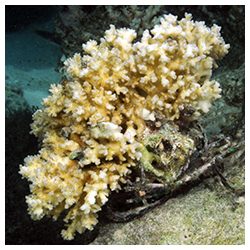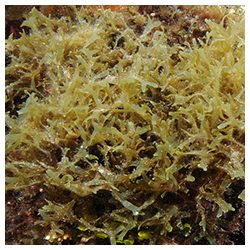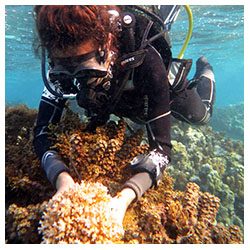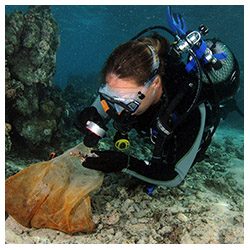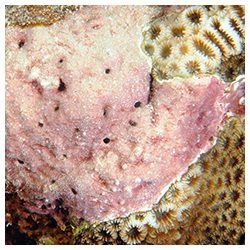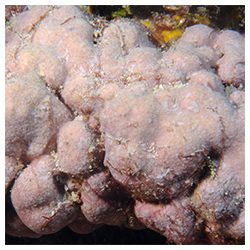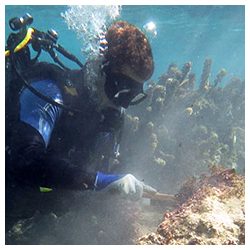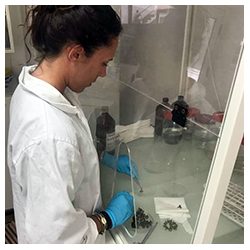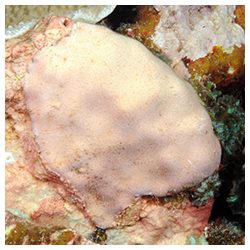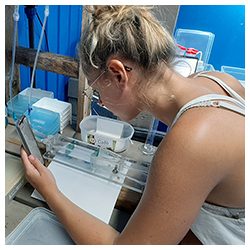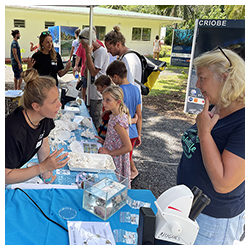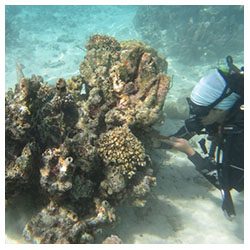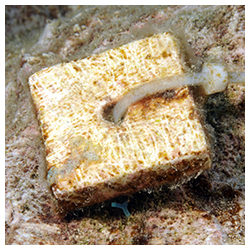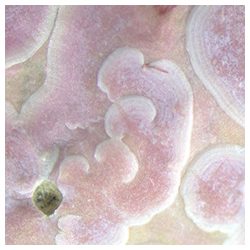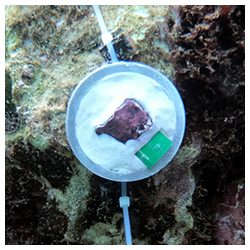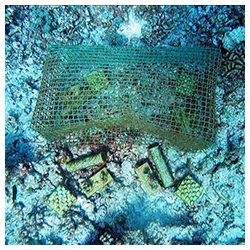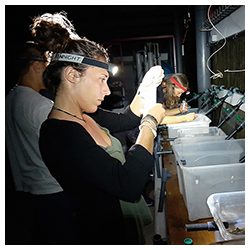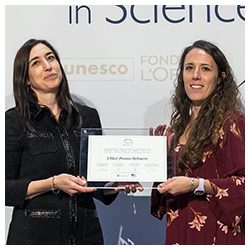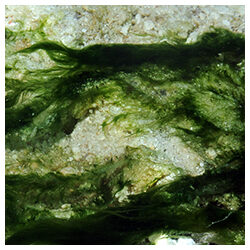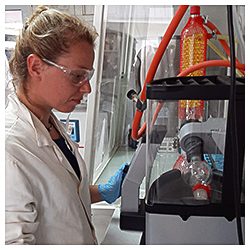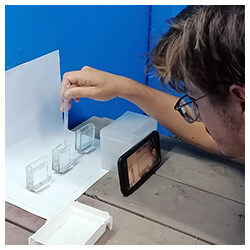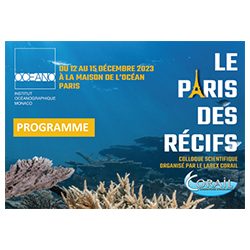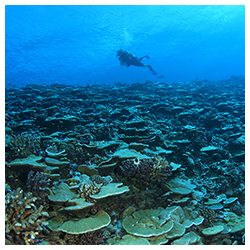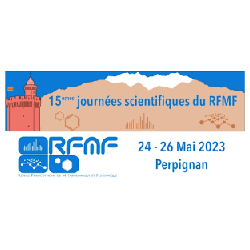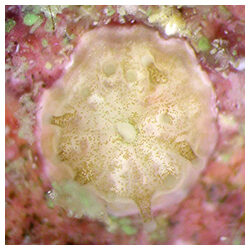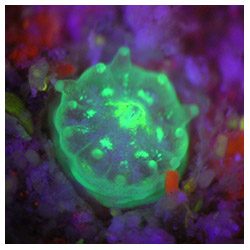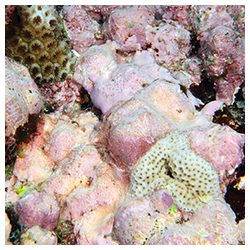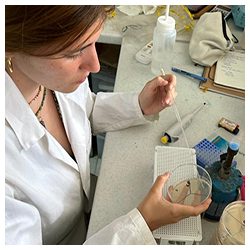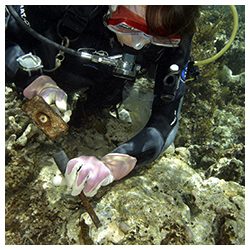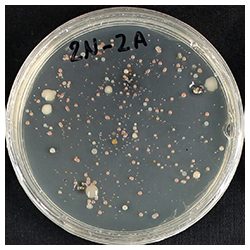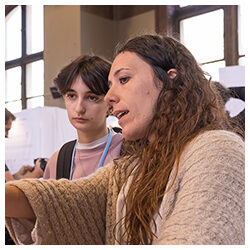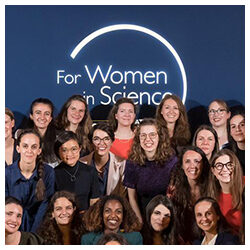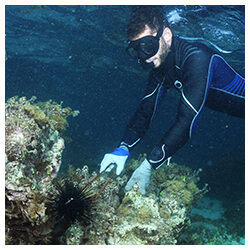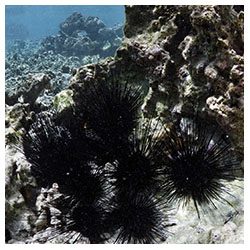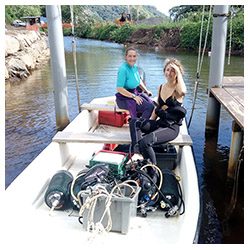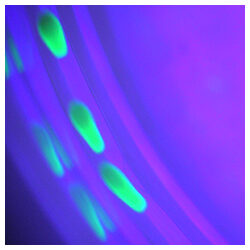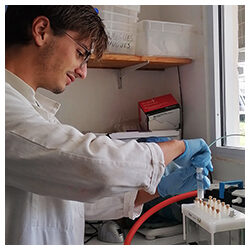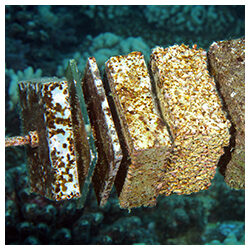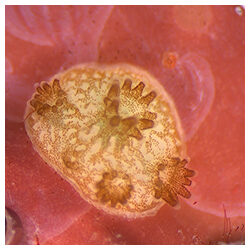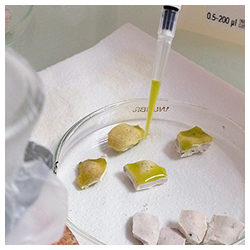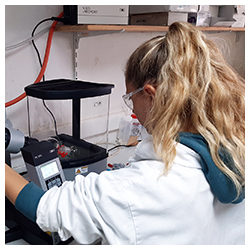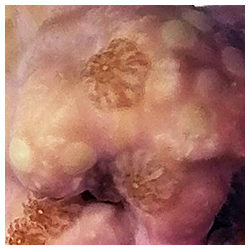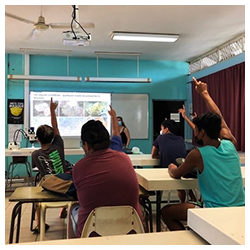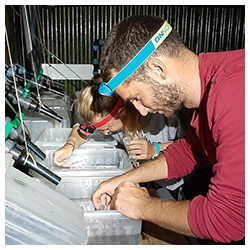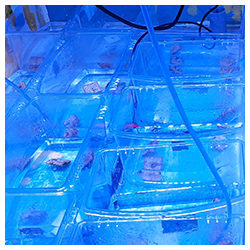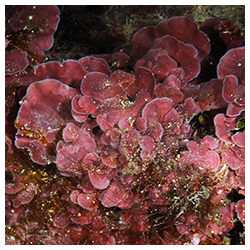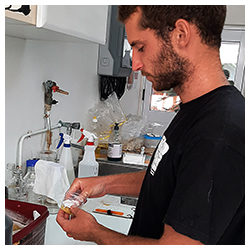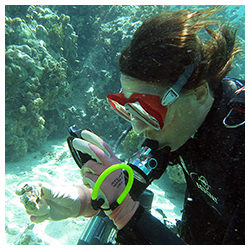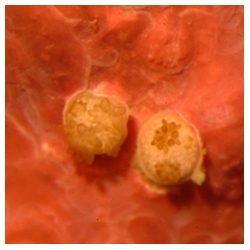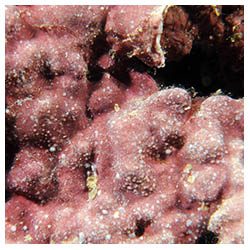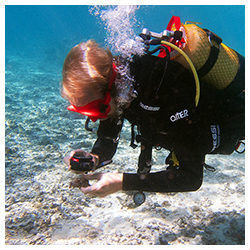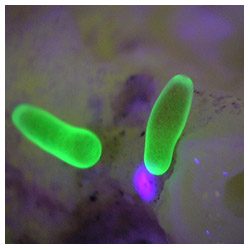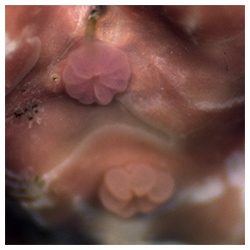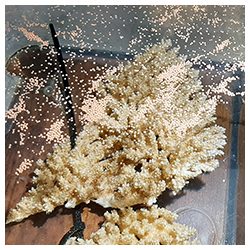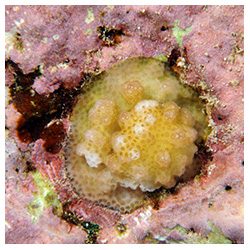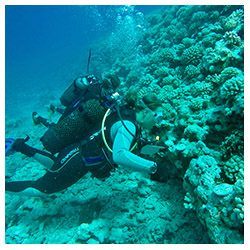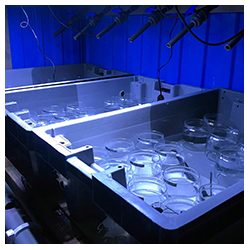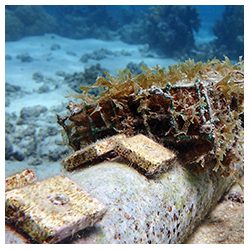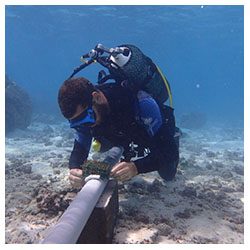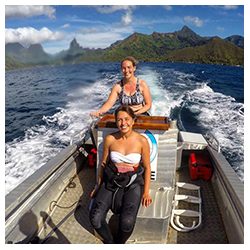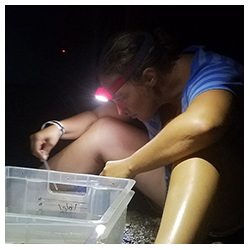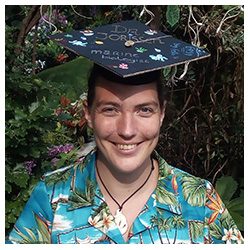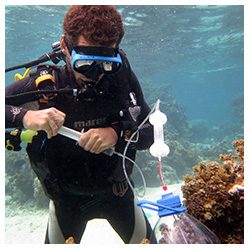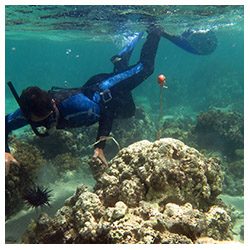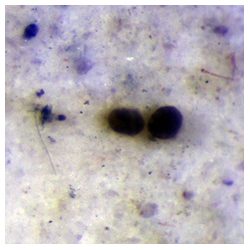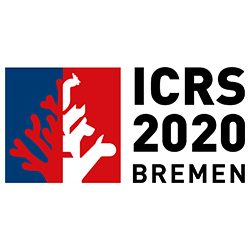August 2025
New paper on the effects of macroalgae on the coral metabolome and microbiome
The accumulation of human-induced stressors is causing persistent shifts from the original dominance by corals to a dominance of macroalgae on coral reefs worldwide. These coral-macroalgal phase shifts have increased the prevalence of competitive interactions between coral and macroalgae, yet the context-dependencies under which they operate still lack understanding.
We used a manipulative field experiment in Mo‘orea, French Polynesia, to investigate how interactions with the allelopathic macroalga Dictyota bartayresiana and flow direction influence the microbiome and metabolome of the coral Pocillopora acuta. By combining 16S rRNA metabarcoding and untargeted metabolomics (LC-MS/MS) data, we showed that contact and close proximity interactions trigger distinct microbial and chemical changes within the coral holobiont and its near-surface water. We assessed the within-colony variability of coral response by sampling apex and side fragments (i.e., living fragments closest to the interaction zone) and showed that microbial dysbiosis was spatially constrained to the interaction zone. In contrast, the metabolomic response was similar between apex and side fragments, supportive of a colony-wide metabolomic response.
This study provides evidence for water-mediated effects under natural flow conditions and clarifies the spatial scale and environmental factors under which these effects occur. Our multi-omic approach revealed that microbial shifts coincided with changes in lipid metabolism and production of defense metabolites and highlighted strong co-variations between specific microbes and metabolites.
Together, the data presented herein illustrate potential coral defense mechanisms in response to microbial invasion and algal allelopathy, further advancing our comprehension of coral holobiont response to algal competition.
Congratulations to Chloé for such great work!
Citation: Pozas-Schacre C, Bischoff H, Vizon C, Raviglione D, Clérissi C, Bonnard I, Nugues MM (2025) Contact- and water-mediated interactions with an allelopathic macroalga drive distinct coral microbiome and metabolome. Environmental Microbiology 27: e70160.
August 2025
New paper on the metabolome of crustose coralline algae
The metabolome is the ultimate representation of the physiological state of an organism in a given environment, and its variability provides insight into how organisms adapt to changing environments. Yet, fluctuations in the metabolome of marine algae have been hardly investigated.
We used an untargeted metabolomic approach to explore the metabolomic composition of seven species of crustose coralline algae (CCA) commonly found on the coral reefs of Moorea, French Polynesia. We developed an extraction method to characterize the CCA metabolome and explored the chemical variations of CCA across species, reef habitat and microhabitat.
Our results demonstrated the robustness and reproducibility of the extraction method. We found a phylogenetic and metabolomic link in CCA species and a variability in the metabolome of certain species across reef habitats and microhabitats. Together these findings showed that the CCA metabolome is structured by phylogeny and environmental conditions.
Congratulations to Camille for such nice work!
Citation: Vizon C, Lagourgue L, Jorissen H, Raviglione D, Payri CE, Bonnard I, Nugues MM (2025) The metabolome of crustose coralline algae is driven by phylogeny and environmental conditions. Algal Research 90: 104146.
January 2025
New paper on the effects of macroalgae on chemical and microbial waterscapes
Coral reef functioning is underpinned by a tight coupling between microorganisms and metabolites. Benthic organisms, like stony corals, macroalgae or turf, release an extensive amount of dissolved and particulate organic matter underpinning reef community metabolism. The combination of molecular exchanges and microbial processes within reef waters results in complex chemical and microbial waterscapes which are just starting to be deciphered. However, in-situ and integrative analyses of these waterscapes remain scarce, limiting our understanding of the origin and spatial distribution of reef metabolites and microbes.
In this paper, we describe a manipulative experiment in Mo‘orea, French Polynesia, investigating how macroalgae shape the microbial and chemical composition of reef boundary layers. By integrating metabarcoding and untargeted metabolomic data, we demonstrate that the multiomic signatures of reef waters were stratified according to boundary layers and macroalgal dominance. We show a remarkable small-scale spatialization of microbes and metabolites across boundary layers and covariation patterns between algal-associated microbes and metabolites, which may be relevant for reef biogeochemical processes and coral-macroalgal competition. Our analyses identified specific classes of algal-derived metabolites diffusing into the water column according to their polarity and suggest that some of these metabolites are involved in allelopathic interactions and select for microbial communities inimical to corals.
We conclude that macroalgae generate complex chemical and microbial waterscapes, which could play essential roles in the function and resilience of coral reefs.
Congratulations to Chloé for such magnificent work!
Citation: Pozas-schacre C, Bischoff H, Raviglione D, Chaïb S., Clérissi C, Bonnard I, Nugues MM (2025) Invasive macroalgae shape chemical and microbial waterscapes on coral reefs. Communications Biology 8: 16.
December 2024
New paper on the microbiome of crustose coralline algae
Crustose coralline algae (CCA) are major framework builders and carbonate producers in tropical reefs (see our April 2023 News). They also serve as important settlement substrates for coral recruits, a process which could be linked with their microbiomes (see our July 2021 News). This study explores the diversity and potential role of the CCA microbiomes within a wide range of CCA species across six islands of the Tuamotu archipelago in the Pacific Ocean during the Tara Pacific expedition. We used the CCA chloroplasts to classify CCA morphotypes and also compared coral recruits’ microbiomes with those of the algae they grew on to test whether the interaction could influence the coral’s microbial composition.
We found that the CCA microbiome varied across geographic locations and species and was related to host phylogeny in two species (a pattern called phylosymbiosis). Although the microbial community of coral recruits varied according to the substrate on which they grew, there was no evidence that the CCA microbiome act as a microbial reservoir for coral recruits.
Congratulations to Corentin and Pierre for such nice work !
Citation: Hochart C, Rouzé H, Rivière B, Ruscheweyh H-J, Hédouin L, Pochon X, Steneck RS, Poulain J, Belser C, Nugues MM, Galand PE (2024) High diversity of crustose coralline algae microbiomes across species and islands, and implications for coral recruits. Environmental Microbiome 19: 112.
October 2024
Congratulations Dr. Camille Vizon !
Camille successfully defended her PhD thesis “Chemical and microbial mediators as key structuring elements for coral recruitment” at the University of Perpignan on October 18th, 2024. Her defense comprised a slide presentation lasting 45 minutes, followed by 2 hours of questions from five jury members. Colleagues, friends and family were able to attend in person or to follow remotely. The event was followed by a food and drink celebration with a great wine tasting session from her hometown.
Congratulations Camille! It has been great working with you. We are very proud of you!
July 2024
New paper on the effects of macroalgae on corals
The accumulation of human-induced stressors is causing persistent shifts from the original dominance by corals to a preponderance of macroalgae on coral reefs worldwide. By impairing coral holobiont health and recruitment success, macroalgae constitute an extensive threat to coral replenishment processes. Whether parental effects of macroalgae on coral recruitment exist and whether they influence coral offspring performance via effects on the larval microbiome represent major gaps of knowledge in our understanding of the mechanisms by which macroalgae may prevent coral recovery.
In this paper, we demonstrate that dense macroalgal assemblages alter the coral larval microbiome and have negative parental and offspring environmental effects on coral recruitment. We used a manipulative field experiment in Mo’orea, French Polynesia, to investigate how macroalgal assemblages influence the microbiome of larvae and adults of the coral Pocillopora acuta. Using 16s rRNA metabarcoding data, we show that dense macroalgal assemblages alter the microbiome of coral larvae, but not adult corals. We then assessed the relative influence of parental and environmental effects on coral recruitment processes by reciprocally exposing coral larvae from two parental origins (i.e., colonies originating from algal-removed vs. algal-dominated bommies) to algal-removed and algal-dominated environmental conditions in a series of survival and settlement experiments. Our results demonstrate that environmental and parental effects combine to negatively influence offspring survival throughout the recruitment process and suggest that these effects could be mediated by alterations in the larval microbiome.
Overall, this study challenges our conception of the mechanisms driving coral-algae competition by revealing unprecedent interacting parental and offspring environmental effects on coral recruitment success. Importantly, our data demonstrate an additional mechanism by which macroalgae favor their persistence on degraded reefs. It also provides important new knowledge on the response of coral microbiomes to macroalgal dominance and how it relates to offspring performance.
Congratulations to Chloé and Hugo for such nice work!
Citation: Pozas-schacre C, Bischoff H, Clérissi C, Nugues MM (2024) Negative parental and offspring environmental effects of macroalgae on coral recruitment are linked with alterations in the coral larval microbiome. Royal Society Open Science 11: 240187.
July 2024
New paper on CCA growth and calcification
Crustose coralline algae (CCA) play a critical role in the ecology and resilience of coral reefs by contributing to reef carbonate production and facilitating coral recruitment. Our team investigated the spatial and seasonal dynamics of growth and calcification of three species of crustose coralline algae differing in their microhabitat preferences (exposed, subcryptic and cryptic). Species identification was based on morphological observations and genetic characterisation.
We showed that CCA growth and calcification is species-specific and spatially and temporally variable. Annual net calcification rates were highest in the exposed species (Porolithon cf. onkodes), intermediate in the subcryptic species (Neogoniolithon cf. megalocystum) and lowest in the cryptic species (Lithophyllum sp.). Although growth and/or calcification rates differed between time intervals for all species, we found no consistent seasonal pattern. P. cf. onkodes and N. cf. megalocystum had higher marginal growth rates at the fore reef habitat relative to the back reef habitat. This difference coincided with a lower occurrence of epiphytes on their crusts in the fore reef, suggesting that species interaction may be an important spatial driver of CCA growth.
This study highlights the need to consider subcryptic and cryptic CCA in reef carbonate budgets and provide important baseline information to understand how CCA communities are responding to environmental changes.
Congratulations to Camille for such nice work!
Citation: Vizon C, Lagourgue L, Payri CE, Nugues MM (2024) Seasonal growth and calcification of three species of crustose coralline algae in Moorea, French Polynesia. Marine Ecology Progress Series 739: 31–48.
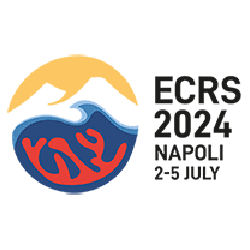
July 2024
ECRS 2024 commences
The European Coral Reef Symposium 2024 has opened its doors from 2 - 5 July 2024 in Naples, Italy. The symposium brings together coral reef scientists, researchers, conservationists, policymakers and reef managers to present the latest research findings and exchange current knowledge critical to advising international and national policies in the conservation and sustainable use of coral reefs. For this edition, the aim is to bridge knowledge gaps between tropical, temperate, and cold-water coral reefs.
Our team will give two oral presentations. Camille Vizon will present the results of her paper published in Harmful Algae (see our January 2024 News). Camille Leonard will give a talk entitled “Optimizing nursery rearing, outplanting, sexual reproduction and innovative artificial materials for coral restoration in French Polynesia”.
Good luck to all presenters !
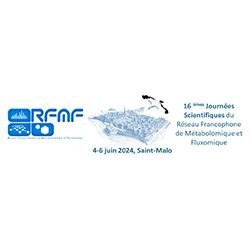
June 2024
16th scientific day of the RFMF commences
The 16th scientific day of the RFMF (Réseau Francophone de Métabolomique et Fluxomique) has opened its doors from 4 - 6 June 2024 in Saint-Malo, France. Main themes of the conference are the applications of metabolomics and fluxomics in the following fields: Health, Agrosciences, Terrestrial and marine environments. The meeting gathers about 300 participants.
Camille Vizon will give an oral presentation on how metabolomics and metabarcoding approaches can reveal the importance of unseen players from benthic organisms in the behavior of coral larvae.
Good luck Camille !
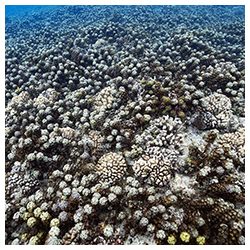
May 2024
MECATUR field experiment launched !
Manola and Manon have launched a field experiment aiming to investigate the effects of herbivory, nutrients and substratum complexity on the abundance and growth of Turbinaria ornata as part of the MECATUR project. Manola Bejarano is a Master student from the University of La Rochelle and Manon Marco, a Master student from the University Littoral Côte d’Opale (UCLO). Both students dive in buddy team to follow the survival and growth of transplanted algae in the experimental plots. It is expected that the results of this experiment will provide useful management recommendations to control the proliferation of T. ornata on the fore reef of Moorea.
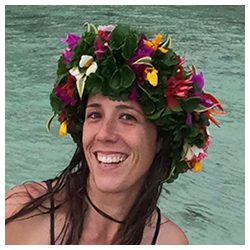
April 2024
Congratulations Dr. Chloé Pozas-schacre !
Chloé successfully defended her PhD thesis “Chemical and microbial effects of macroalgae on coral holobionts and reef ecosystems” at the University of Perpignan on April 12th, 2024. Her defense comprised a slide presentation lasting 45 minutes, followed by 2 hours of questions from five jury members. Colleagues, friends and family were able to attend in person or to follow remotely. The event was followed by a food and drink celebration on the outdoor terrace of our lab.
Congratulations Chloé! It has been a pleasurable time working with you. We are so proud of you!
January 2024
New paper on benthic cyanobacterial mats
Benthic cyanobacterial mats (BCMs) are becoming increasingly abundant on coral reefs worldwide. Our team studied the allelopathic effects of the benthic cyanobacterium Anabaena sp.1 on larvae of the coral Pocillopora acuta. This cyanobacterium is abundant on coral reefs of many tropical and sub-tropical areas worldwide, including Moorea, and produces major cyclic lipopeptides of the laxaphycin family with cytotoxic properties.
We found that Anabaena crude extract reduces both larval survivorship and settlement and that laxaphycin B reduces settlement, unlike laxaphycin A. When larvae were exposed to both laxaphycin A and B, there was a reduction in both larval survival and settlement.
To assess the potential of the cyanobacterium to affect coral recruitment in the natural environment, we measured in situ laxaphycin concentrations at different distances from Anabaena mats across horizontal and vertical gradients during two time periods on the fringing reefs of Moorea. Laxaphycin A and B concentrations increased with increasing proximity to Anabaena mats, with concentrations being consistently above LC50 and EC50 thresholds within a 1 cm distance of the mats.
To our knowledge, this is the first study that establishes the link between the toxicity of cyanobacterial allelochemicals for coral larvae and their natural toxin concentrations in the field and that demonstrates a combined impact between two cyanobacterial metabolites on marine invertebrate larvae. The results of this study provide important mechanistic insights into the ecological impacts of cyanobacterial secondary metabolites and how they could contribute to ongoing reef degradation and gradual shifts to BCM-dominated states.
Congratulations to Camille Vizon and Axel Urbanowiez for such nice work!
Citation: Vizon C, Urbanowiez A, Raviglione D, Bonnard I, Nugues MM (2024) Benthic cyanobacterial metabolites interact to reduce coral larval survival and settlement. Harmful Algae 132: 102582.
December 2023
Labex CORAIL Symposium: "Le Paris des récifs"
From December 12th to 15th 2023, the Labex CORAIL organises a symposium on coral reef science and conservation in Paris. The symposium includes scientific presentations, as well as evening events at the Aquarium de Paris and in the Caroussel du Louvre and afternoon round tables on citizen science and innovative solutions for reef restoration.
Chloé Pozas-schacre and Camille Vizon will present their thesis work in short 5 minutes presentations.
Good luck to Camille and Chloé !
June 2023
New paper on the ecology of Endozoicomonadaceae in three coral genera across the Pacific Ocean
Coral holobionts include complex microbial communities composed of viruses, fungi, archaea, bacteria, and microalgae. Among these microorganisms, the bacteria family Endozoicomonadaceae is known to be commonly associated with corals. This paper aimed to investigate new species of Endozoicomonadaceae in order to gain a better understanding of their distribution and the roles these bacteria play in coral health and functioning. To achieve this, the authors extracted the genetic material of these bacteria from samples of three coral genera - Pocillopora (cauliflower corals), Porites (stony corals), and Millepora (fire corals) - collected from 99 reefs across 32 islands in the Pacific Ocean during the Tara Pacific expedition.
This research led to identify three new species of bacteria, each associated with a distinct coral genus. This finding suggests that corals have developed a strong and evolving relationship with their associated bacteria, which provide beneficial effects. Notably, each bacterial species produced a different array of B vitamins, which are essential for coral growth and may play significant roles in coral health and immunity. Furthermore, these findings highlight that different coral genera exhibit distinct strategies of host-Endozoicomonadaceae associations, which are determined at the bacterial lineage level.
Congratulations to Corentin and Pierre !
Citation: Hochart C, Paoli L, Ruscheweyh H-J, Salazar G, Boissin E, Romac S, Poulain J, Bourdin G, Iwankow G, Moulin C, Ziegler M, Porro B, Armstrong EJ, Hume BCC, Aury J-M, Pogoreutz C, Paz-García DA, Nugues MM, Agostini S, Banaigs B, Boss E, Bowler C, de Vargas C, Douville E, Flores M, Forcioli D, Furla P, Gilson E, Lombard F, Pesant S, Reynaud S, Thomas OP, Troublé R, Wincker P, Zoccola D, Allemand D, Planes S, Vega Thurber R, Voolstra CR, Sunagawa S, Galand PE (2023) Ecology of Endozoicomonadaceae in three coral genera across the Pacific Ocean. Nature Communications 14:3037.

May 2023
Congratulations Dr. Corentin Hochart !
Corentin successfully defended his PhD thesis “Ecology of bacterial symbionts associated with corals and crustose coralline algae in the Pacific Ocean: from genomes to communities” at the Oceanological Observatory of Banyuls-sur-Mer on May 30th, 2023. His defense comprised a slide presentation lasting 45 minutes, followed by 2 hours of questions from five jury members. The jury announced its unanimous verdict end of the afternoon, saying that he had passed.
Congratulations Corentin! We are so proud of you!
May 2023
15th scientific day of the RFMF commences
The 15th scientific day of the RFMF (Réseau Francophone de Métabolomique et Fluxomique) has opened its doors from 24 - 26 May 2023 in Perpignan, France. Main themes of the conference are the applications of metabolomics and fluxomics in the following fields: Microbiology, Biotechnology, Plants, Feed, Health, Pharmacology / Toxicology and Environment. The meeting gathers about 250 participants.
Chloé Pozas-schacre will give an oral presentation on the chemical and microbial composition of macroalgal-associated boundary layers.
Good luck Chloé !
April 2023
Investigating natural patterns of association between crustose coralline algae and coral recruits
The CoralMates team has gathered a comprehensive knowledge of the genetic diversity of crustose coralline algae (CCA) in Moorea (see our September 2021 News). To follow up on this extensive research effort, Maggy and Clément Esclavy, a Master student from the University of Algarve, Portugal, are searching for coral recruits using ultraviolet lighting in situ and are collecting data on their surrounding benthos. Ultraviolet lighting enhances the detection of corals through the excitation of their green fluorescent proteins allowing to visualise recruits as small as 1 mm in diameter. Using this new dataset, the team aims to establish a matrix of functional characteristics that rank CCA species from best potential coral facilitators to worst (i.e., inhibitors).
April 2023
New paper on crustose coralline algae carbonate production
Coral reefs are formed via the production and accretion of calcium carbonate by various calcifying organisms. Together with scleractinian corals, crustose coralline algae rank among the major framework builders and carbonate producers in tropical reefs. In this paper, we found that, under the certain conditions, they can match or even exceed the contribution of corals to reef carbonate production. We also provide several recommendations to improve the inclusion of crustose coralline algae into carbonate budgets under the ongoing climate crisis.
Maggy is very proud to have contributed to this paper. A must read!
Citation: Cornwall CE, Carlot J, Branson O, Courtney TA, Harvey BP, Perry CT, Andersson AJ, Diaz-Pulido G, Johnson MD, Kennedy E, Krieger EC, Mallela J, McCoy SJ, Nugues MM, Quinter E, Ross CL, Ryan E, Saderne V, Comeau S (2023) Crustose coralline algae can contribute more than corals to coral reef carbonate production. Communications Earth & Environment 4:105
March 2023
Finding bacteria that induce coral settlement
Corals produce dispersive, planktonic larvae, which must recruit onto appropriate benthic surfaces to complete their life cycle. The recovery of coral populations thus critically depends on the settlement (when larvae first attach to the benthos) and subsequent survival (recruitment) of new individuals. Together with scleractinian corals, crustose coralline algae (CCA) are major framework builders and carbonate producers on tropical reefs. They also host a diversity of epiphytic bacteria or other microorganisms on their surfaces that could act as settlement inducers for larvae of several marine invertebrates, including corals.
Cassandra Le Bélicard, a Master student at the Institute Agro Montpellier, joined the CoralMates team to isolate CCA-associated bacteria and to test their ability to induce coral settlement. She was trained in bacterial isolation and culturing work at the Oceanological Observatory of Banyuls-sur-Mer (OOB) in February. This month, the team sampled crustose coralline algae in the field. Cassandra is running bacterial isolation and culturing at the CRIOBE station in Moorea. She will perform coral settlement assays using monospecific biofilms over the next couple of months.
October 2022
Chloé named one of the 2022 Fondation L’Oreal-UNESCO French Young Talents
This prize awarded 35 women scientists, PhD and post-doctoral researchers, for their contribution to science. Gender inequalities remain anchored in our society with only 30% of women scientists worldwide. Yet, to be innovative, science needs to be inclusive and diverse. In more than 110 countries, the For Women In Science - Young Talents program has the vocation to empower women scientists and to give them visibility in their early career. By shedding light on women researchers and by reaching out girls, the program aims to inspire the next-generation to pursue in science.
In October, the laureates followed a training in leadership so they can have the tools to get more confident and to break the glass ceiling. This inspiring week ended by the prize ceremony at the CNAM (Centre National des Arts et des Métiers) in Paris. This program was a great opportunity for Chloe to talk about her research to the general public and to raise concern about the challenges in coral reef resilience.
Congratulations to Chloé !
Some media coverage (French only)
- Université de Perpignan Via Domatia
Some interesting readings in gender inequality and stereotype in science
- Program website For Women in Science
- PNAS article « Intersectional inequalities in science »
- Rapport de l’Enseignement Supérieur, Recherche et Innovation 2022 (French only)
September 2022
New paper in Marine Ecology Progress Series
Over the last four decades, canopy-forming macroalgae have invaded the lagoon of Moorea. In a previous study (Bulleri et al. 2018), our team showed that these algae can alter the composition of epilithic bacterial assemblages and reduce coral recruitment. When consumer pressure is low, macroalgae can rapidly colonize space freed by disturbances. Thus, restoration of herbivore populations has been identified as a priority for sustaining coral reef resilience in the face of increasing intensity and frequency of extreme events.
Grazing sea urchins could limit macroalgal growth and maintain coral reef resilience. As part of the TURBOCORAIL project, we have launched a manipulative field experiment to test the interactive effects of macroalgal removal and sea urchin densities on the dynamics of macroalgae (see our December 2019 News). The experiment was maintained for 1 yr with regular adjustments of sea urchin densities.
Results show that urchins, even when at intermediate densities, did not generate major changes in the structure of benthic assemblages on experimental bommies. This study suggests that a moderate increase in diadematid densities is unlikely to be effective in controlling macroalgal canopies in Moorea back reefs unless associated with the recovery of other herbivore guilds able to remove adult macroalgae (i.e. browsers) and, likely, reductions in nutrient loading. It remains to test whether higher diadematid densities might be more effective in controlling macroalgal canopies.
Congratulations to Fabio and the four students involved in the project, Chloé, Hugo, Stéphanie and Julien !
Citation: Bulleri F, Pozas-Schacre C, Bischoff H, Bramanti L, D’agata S, Gasc J, Nugues MM (2022) Compounded effects of sea urchin grazing and physical disturbance on macroalgal canopies in the lagoon of Moorea, French Polynesia. Marine Ecology Progress Series 697: 45–56
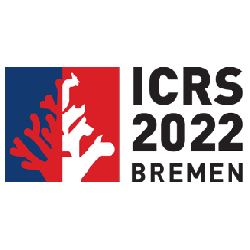
July 2022
ICRS 2022 commences
The 15th International Coral Reef Symposium has opened its doors from 3 - 8 July 2022 in Bremen, Germany. Maggy and Fabio will give oral presentations on diadematid sea urchins. Camille Léonard will present the results of her paper published in Restoration Ecology (see our February 2022 News).
Maggy will chair a session with Christopher Cornwall, Steve Comeau and Guillermo Diaz-Pulido entilted "Coralline algae: what are their global contributions to coral reefs now and in future oceans?"
Good luck to all presenters and chair !
May 2022
New paper in Marine Ecology Progress Series
Check out the last paper of the PhD thesis of Hendrikje Jorissen that just came out in MEPS. Ocean acidification affects the calcification of organisms, such as reef-building corals and calcifying algae. However, calcification is not the only ecological process affected. In this paper, we explored the behavioral response and settlement preferences of two species of broadcast spawning corals to a range of CO2 concentrations. We found that coral larvae avoid benthic probing and settle less in response to high CO2, suggesting that ocean acidification may also reduce coral recruitment.
Congratulations to Hendrikje and her two students, Lauranne and Anaïs !
Citation: Jorissen H, Martin A, Sarribouette L, Hédouin L, Nugues MM (2022) High CO2 inhibits substratum exploration and settlement of coral larvae. Marine Ecology Progress Series 689: 47–56
April 2022
Do algal secondary metabolites affect coral larvae?
Benthic algae and cyanobacterial mats could affect coral larvae via the release of chemicals. Axel Urbanowiez, a Master student from the University of Toulon, joined the CoralMates team last January. To investigate the effects of algal and cyanobacterial exudates on coral larvae, Camille and Axel are running survival, behavioral and settlement assays using exudates of several species of algae and cyanobacteria. To determine whether the effects are due to secondary metabolites, they extract exudates using solid phase extraction (SPE). Trapped compounds are then eluded and used in the assays.
February 2022
New paper in Restoration Ecology
Despite the accelerating research in the field of coral restoration, novel materials (e.g., biomaterials) and technologies (e.g., 3D and 4D printing) have been hardly explored. These novel technologies and materials could be used on artificial reefs to promote coral recruitment. Camille Leonard, PhD candidate at the EPHE, and the CoralMates team compared the efficiency of eight innovative and two commonly used materials as recruitment substrates for corals.
Tiles made of the different materials were deployed for 6 months during major coral spawning events on the forereef of Moorea. Results showed that several innovative materials such as 3D printed concrete, PVC with chitosan coating, fiberglass polymer, and flax-based polylactic acid are promising materials for use as coral recruitment substrates on artificial reefs. We found that materials that (1) are durable and (2) harbor microgrooves effectively support high coral recruitment. In addition, the composition of the benthic communities colonizing the tiles strongly influenced coral recruitment. Materials encouraging the recruitment of non-coralline encrusting red algae deterred coral recruitment, while materials colonized by thin turf algae (<5 mm in height) and encrusting foraminiferans supported high coral recruitment.
Congratulations to PhD student Camille Leonard and the entire team from Seaboost, TotalEnergies and CRIOBE !
Citation: Leonard C, Hédouin L, Lacorne MC, Dalle J, Lapinski M, Blanc P, Nugues MM (2021) Performance of innovative materials as recruitment substrates for coral restoration. Restoration Ecology doi: 10.1111/rec.13625
December 2021
Last Acropora spawning month
December is the last spawning month for the genus Acropora before spawning resumes again next year in September. To identify the algal chemical compounds playing a role in coral larval settlement, Camille and Hugo prepare chemical extracts from crustose coralline algae using different extraction techniques. They add the extracts to dead algal fragments and leave them to dry. They then expose larvae of A. retusa to the fragments to assess the capacity of the extracted compounds to induce coral settlement.
November 2021
World Science Day at CRIOBE
This month, the CoralMates team celebrated the World Science Day at CRIOBE. Camille and Hugo set up a stand on coralline algae open to the general public. They also gave a lecture on coralline algae to two classes of middle school pupils in Afareaitu. Visitors and pupils discovered a variety of algal species and could observe them under a binocular microscope. These events created the opportunity to raise public and young children awareness about coral reef ecosystems and the importance of coralline algae in their structure and function.
October 2021
Spawning season 2021 up and running
October-December is the big spawning season for the coral genus Acropora in Moorea, providing exciting research opportunities to study the early life history stages of this genus. This month, the CoralMates team is raising larvae from Acropora cytherea and is studying the importance of bacteria in the coral settlement process. Bacteria, especially those in biofilms, play an important role in emitting cues for coral larvae. Environmental conditions can change bacterial biofilm communities and in turn affect settlement of coral larvae. To assess relationships between settlement rates and bacterial community composition, the team is running settlement experiments on biofilms from different habitats.
September 2021
Genetic characterisation of crustose coralline algae
Despite their ecological importance, crustose coralline algae (CCA) are often overlooked or ignored due to their complex taxonomy. Their reproductive and vegetative structures provide the critical anatomical characters used in taxonomy, but also create major obstacles for researchers, since complicated decalcification techniques and microtome sectioning of infrequently present cryptic features are required.
This month, the CoralMates team is collecting CCA specimens at several sites around the island of Moorea. Specimens are provisionally identified to species level in situ and collected. Back in the laboratory, each specimen is divided in two fragments. One fragment will be screened for the commonly applied markers which are group specific including two nuclear loci (SSU and LSU), one plastidial (psbA) and one mitochondrial (COI) genes. Claude Payri will be in charge of the genetic analyses. The second fragment is further characterized morphologically and kept as voucher.
This combination of morphological and molecular approaches should enhance coralline algal diversity knowledge in French Polynesia with potentially new described species. The collection will be illustrated in a dedicated atlas on most common coralline species from Moorea.
July 2021
New paper in Scientific Reports
Crustose coralline algae (CCA) are a group of calcifying red algae commonly found in coral reefs worldwide. They act as highly inductive settlement surfaces for corals. However, the chemical and microbial properties of CCA that induce coral settlement are still poorly known.
In this paper, we combine information on the microbiome and metabolome of six CCA species to explore how larvae of the coral species Acropora cytherea perceive chemical and microbial signals from these algae and their associated bacterial communities.
First, we show that one species of CCA (Titanoderma prototypum) significantly promotes coral settlement on its surface and that this species also has a very distinct bacterial community and metabolomic fingerprint. These results support the hypothesis that the distinct microbiome and metabolome of this species may promote the settlement and attachment of coral larvae.
Secondly, we found that coral settlement rates and the microbiome and metabolome of the algae are specific to the CCA habitat (exposed, subcryptic or cryptic), which suggests that microbes and/or chemicals could serve as environmental indicators for coral larvae seeking suitable habitat and substrate.
Our study increases our knowledge of the metabolome and microbiome of crustose coralline algae and provides a basis for future research into the role of microorganisms and metabolites in the fine-scale dynamics of coral recruitment.
Well done Hendrikje!
Citation: Jorissen H, Galand PE, Bonnard I, Meiling S, Raviglione D, Meistertzheim A-L, Hédouin L, Banaigs B, Payri CE, Nugues MM (2021) Coral larval settlement preferences linked to crustose coralline algae with distinct chemical and microbial signatures. Scientific Reports 11: 14610
April 2021
Coral larvae on the move: Algal effects on larval swimming behaviour
Pierre-Louis Rault, a Master student from the Ecole Pratique des Hautes Etudes (EPHE), joined the CoralMates team to do his Master thesis in January 2021. His goal is to study the effects of algal exudates on the behaviour of coral larvae. He is filming coral larvae swimming inside small home-made tanks which are filled with different algal exudates. To obtain the exudates, algae are collected from the reef and incubated in seawater for several hours in the laboratory. Incubated seawaters are then introduced in the aquaria together with coral larvae. Using the videos, Pierre-Louis is able to analyse larval swimming speed and various types of behavioral displacements. He will then determine how these metrics vary in response to the different algal exudates. This month, he started his first series of tests on larvae released by colonies of Pocillopora damicornis during the new moon.
Click here to download a video of coral larvae swimming in an experimental tank. To give you an idea of the size of a Pocillopora larva, the tank size is 5 cm x 5 cm x 1.2 cm (L x H x W).
Click here to download a close-up video of swimming coral larvae
Videos: Pierre-Louis Rault
December 2020
Chloé invited to talk about her PhD thesis on France Culture (French only)
November 2020
New paper in Coral Reefs
Oxygen is a fundamental driver that mediates a multitude of essential processes and interactions on multiple scales on coral reefs. In adult corals, it directly or indirectly impacts physiological processes, such as photosynthesis, respiration and calcification.
In this new paper, we provide evidence that low-oxygen environments can also impact the early life stages of corals. We show that coral larvae of two Acropora species avoid benthic probing in low-oxygen environments. Moreover, when larvae of these two coral species were offered their preferred settlement substrate, the crustose coralline algae Titanoderma prototypum, along an oxygen gradient, they only settled on Titanoderma fragments placed in the oxygen-rich environment. This last result suggests that low-oxygen areas can disrupt the intimate association between corals and crustose coralline algae.
We conclude that coral larvae can sense oxygen and use it as a cue to avoid settlement in unfavorable environments. To our knowledge, this is a first example of oxytaxis in coral larvae.
Congratulations Hendrikje!
Citation: Jorissen H, Nugues MM (2021) Coral larvae avoid substratum exploration and settlement in low oxygen environments. Coral Reefs 40: 31–39
October 2020
Acropora spawning took off at the CRIOBE station
October is the big spawning month for the coral genus Acropora in Moorea, providing exciting research opportunities to study the early life history stages of this genus. This year we got larvae from two acroporid species: Acropora pulchra and A. cytherea. Camille and Maggy ran larval behavior choice experiments with exudates of different species of crustose coralline algae. Chloé and Hugo settled coral larvae on tiles preconditioned at different distances from macroalgae. Settlement rates were great. Next, the researchers will follow the survival of the newly settled corals over several weeks.
We also got coral spawning in November. Here is a cool video of a colony of Acropora hyacinthus releasing egg-sperm bundles :
Video: Chloé Pozas-Schacre
September 2020
New paper in Coral Reefs
New paper in Coral Reefs shows that the late post-settlement survival of pocilloporid recruits is significantly affected by the presence of crustose coralline algae (CCA) and that there is considerable variability in the outcomes of the interaction between CCA and coral recruits depending on habitat and recruit size.
Contrary to the well-accepted view that CCA facilitate coral recruitment, subcryptic CCA species had a negative effect on the survival of small-sized coral recruits relative to dead CCA control. In contrast, exposed CCA species had a positive effect. By examining the causes of death of the recruits in the experimental treatments, we concluded that, in subcryptic habitats, CCA can reduce the survival and/or growth of coral recruits via direct competitive overgrowth, while, in exposed habitats, they can enhance coral recruitment by alleviating competition with turf algae.
Many coral reef scientists and managers equate CCA (all species) to improved recruitment potential for corals. This paper challenges this view using a robust experimental approach, with important consequences for our predictions of reef recovery potential and the way we manage reefs. Good job Hendrikje!
Citation: Jorissen H, Baumgartner C, Steneck RS, Nugues MM (2020) Contrasting effects of crustose coralline algae from exposed and subcryptic habitats on coral recruits. Coral Reefs 39: 1767–1778
August 2020
Does distance from macroalgae matter to coral larvae?
Chloe and Hugo ran an experiment aiming at testing whether biofilms preconditioned at different distances from macroalgae vary in their abilities to impede coral settlement and recruit survival. Aragonite tiles were preconditioned at different distances from macroalgae for two months in the lagoon of Moorea. To initiate coral settlement, they were placed in glass cylinders filled with seawater together with larvae of the coral Pocillopora damicornis in the laboratory. Settlement rates were estimated after 24h and tiles were replaced in the field to track coral recruit survival after 7 and 15 days. To understand the role of microbes, biofilms were sampled for microbial analyses along with macroalgae-associated bacteria and surrounding seawater. This experiment will be re-launched using coral spawning species next month.
July 2020
On-going experiments in the water and coral larvae
This last two months were marked by the launch of Chloé’s second experiment. This experiment aims to assess whether the effects of macroalgae on reef biofilms are algal species- and distance-dependent and whether these effects are associated with reduced coral recruitment. Once a week, Chloé and Hugo spend one day maintaining and monitoring their experiments in the field. For the first experiment (see May 2020 news), work consists in checking coral health state and macroalgae on algal-removed and control bommies. For the second experiment, the team must maintain macroalgal densities on experimental structures. The two experiments will involve specific tests on larvae of the brooding coral Pocillopora damicornis, which are released from adult colonies once a month. This week, the team will estimate the perfect time to obtain coral larvae.
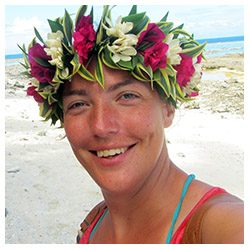
June 2020
Congratulations Dr. Hendrikje Jorissen!
Hendrikje successfully defended her PhD thesis on June 26th after 3.5 years of hard work and dedication. Due to the spread of COVID-19, the defence had to be done using videoconference. It comprised a slide presentation lasting 45 minutes, followed by 2 hours of questions from six jury members. Colleagues, friends and family were able to watch the defence remotely. It’s been great working with you. We are so proud of you!
May 2020
Wet again after 2-month pause due to COVID-19
While Chloe’s PhD fieldwork was in full progress in Moorea, everything got shutdown with the arrival of COVID-19 on the French Polynesian territory in March 2020. Chloé & Hugo Bischoff, a Master student from the University of the French West Indies, had to stay dry at the CRIOBE lab facilities for two long months. However, fieldwork could start again this month. The team cleaned off experimental bommies from macroalgae which had barely grown back. Transplantation of Pocillopora damicornis colonies on the bommies and methodological testing of chemical sampling and flume chambers are now underway. It feels great to be wet again!
March 2020
ICRS 2020 postponed to 2021 due to COVID-19 | Bremen, Germany
Due to the spread of COVID-19, the 14th ICRS has been postponed to the week of 18 - 23 July 2021. The session "Coralline algae: what are their global contributions to coral reefs now and in future oceans?” co-chaired by Maggy with Christopher Cornwall, Steve Comeau and Guillermo Diaz-Pulido remains in the 2021 ICRS program. We hope to see you at the conference in Bremen, Germany, in July 2021. In the meantime, stay safe and healthy!
December 2019
TURBOCORAIL field experiment launched
In November 2019, Fabio manipulated sea urchin and Turbinaria densities on coral bommies in the lagoon of Moorea. The experiment will be maintained by Chloé and other students for the next few months. With this experiment, we hope to know whether different levels of urchin grazing pressure can regulate the spread and persistence of stands of Turbinaria and associated algae. Fabio also experimented with algal spores and chemicals to determine how the benthos affects settlement success of the alga. These experiments will enhance our understanding of the mechanisms underpinning the expansion of Turbinaria and, hopefully, strategies for its control.
October 2019
International Coral Reef Symposium | ICRS2020 | Bremen, Germany
Maggy is co-chairing a session at ICRS with Christopher Cornwall, Steve Comeau and Guillermo Diaz-Pulido entilted "Coralline algae: what are their global contributions to coral reefs now and in future oceans?” We hope to see you at the conference in Bremen, Germany, on July 5-10.
